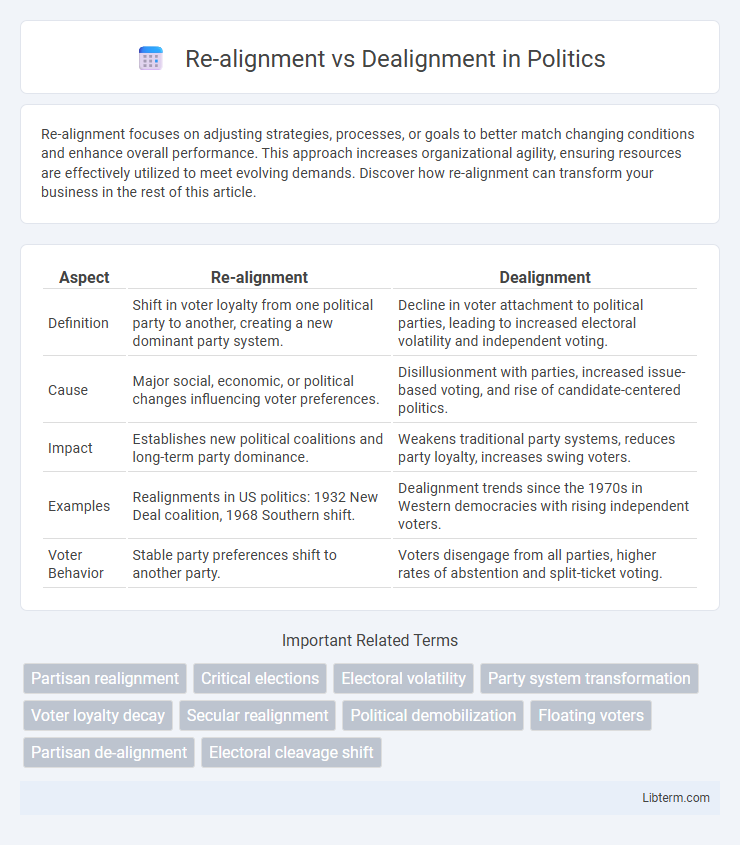Re-alignment focuses on adjusting strategies, processes, or goals to better match changing conditions and enhance overall performance. This approach increases organizational agility, ensuring resources are effectively utilized to meet evolving demands. Discover how re-alignment can transform your business in the rest of this article.
Table of Comparison
| Aspect | Re-alignment | Dealignment |
|---|---|---|
| Definition | Shift in voter loyalty from one political party to another, creating a new dominant party system. | Decline in voter attachment to political parties, leading to increased electoral volatility and independent voting. |
| Cause | Major social, economic, or political changes influencing voter preferences. | Disillusionment with parties, increased issue-based voting, and rise of candidate-centered politics. |
| Impact | Establishes new political coalitions and long-term party dominance. | Weakens traditional party systems, reduces party loyalty, increases swing voters. |
| Examples | Realignments in US politics: 1932 New Deal coalition, 1968 Southern shift. | Dealignment trends since the 1970s in Western democracies with rising independent voters. |
| Voter Behavior | Stable party preferences shift to another party. | Voters disengage from all parties, higher rates of abstention and split-ticket voting. |
Understanding Political Realignment and Dealignment
Political realignment refers to a significant and lasting shift in the patterns of party loyalty and voter behavior, often triggered by critical elections or major social changes. Dealignment signifies a decline in party identification where voters become more independent, resulting in weaker party loyalty and increased electoral volatility. Understanding these concepts is crucial for analyzing trends in voter behavior, party system stability, and the evolution of democratic politics.
Historical Context of Realignment and Dealignment
Historical context reveals that political realignment occurs when significant shifts in party loyalty reshape electoral coalitions, exemplified by the New Deal era's transformation of American politics in the 1930s. Dealignment describes a trend where voters increasingly detach from traditional party affiliations, intensifying from the late 20th century due to social changes, media diversification, and growing political polarization. Key data points include the post-World War II dominance of the Democratic and Republican parties during realignments and the rise of independent voters as a hallmark of dealignment since the 1960s.
Key Differences Between Realignment and Dealignment
Realignment involves a significant and lasting shift in voter loyalty toward a particular party, often triggered by critical elections or major political events, resulting in a new dominant political coalition. Dealignment refers to the gradual weakening of party identification, where voters become more independent and less committed to traditional party affiliations, leading to increased volatility and ticket-splitting in elections. The key difference lies in realignment creating enduring partisan change, while dealignment reflects growing voter disengagement and instability within the party system.
Factors Driving Political Realignment
Political realignment is driven by factors such as significant demographic shifts, economic transformations, and changes in social values, which alter the traditional bases of party support. Dealignment occurs when voters disengage from established political parties due to dissatisfaction or lack of representation, often influenced by media fragmentation, political scandals, or declining party identification. These dynamics reshape the electorate, leading to evolving party coalitions and altering long-term political landscapes.
Causes and Consequences of Dealignment
Dealignment occurs when voters detach from traditional party loyalties due to causes such as political scandals, shifting social values, and increased access to diverse information sources through digital media. This weakening of partisan identification leads to consequences like lower voter turnout, more volatile election results, and the rise of issue-based or candidate-centered politics. The decline in stable party support challenges the predictability of electoral outcomes and often results in fragmented legislatures and coalition governments.
Major Realignment Events in Political History
Major realignment events in political history, such as the New Deal Coalition of the 1930s and the Southern realignment in the late 20th century, significantly shifted party loyalties and voter bases. These transformations contrast with dealignment, where voters gradually disengage from traditional party affiliations without a clear shift to another party, leading to increased political volatility. Realignments often coincide with pivotal social or economic crises, producing enduring changes in the political landscape.
Societal Impacts of Dealignment Trends
Dealignment trends lead to increased voter apathy, weakening traditional party loyalties and fragmenting political landscapes. This shift disrupts established social cohesion, as communities lose shared political identities that once fostered collective action and trust. The erosion of stable party allegiance often correlates with rising polarization, reducing effective dialogue and hindering democratic responsiveness to societal needs.
Realignment, Dealignment, and Voter Behavior
Realignment refers to a significant and lasting shift in the political landscape where large groups of voters change their party loyalty, often triggered by critical elections or major societal changes. Dealignment signifies a decline in voter attachment to traditional parties, leading to increased independence and volatile voting patterns. Understanding voter behavior involves analyzing how realignment reflects evolving political identities and ideologies, while dealignment highlights growing disillusionment and fragmentation within the electorate.
Realignment vs Dealignment: Implications for Political Parties
Realignment signifies a durable shift in voter loyalty, often triggered by critical elections that reshape party coalitions and policy priorities. Dealignment reflects voter disengagement from traditional party affiliations, leading to increased volatility and the rise of independent or third-party candidates. Political parties must adapt strategies during realignments to consolidate new support bases, while dealignment challenges parties to reconnect with disillusioned or fragmented electorates.
Future Trends: Realignment, Dealignment, and Political Change
Future trends indicate a potential resurgence of political realignment as demographic shifts and emerging social issues reshape party coalitions, leading to new voter bases and ideological landscapes. Dealignment may continue as disillusionment grows, with increasing numbers of voters rejecting traditional party identities, driving volatility and unpredictability in elections. These dynamics suggest an evolving political environment where adaptive strategies and issue-based politics become critical for sustained electoral success.
Re-alignment Infographic

 libterm.com
libterm.com